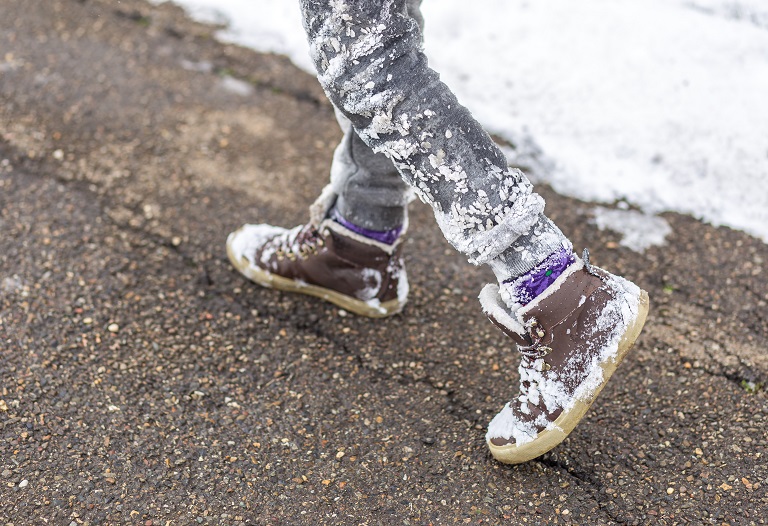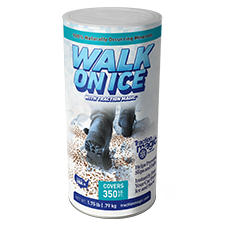How To Deal With Ice Melt Damage On Your Driveway

If you’re reading this article, it’s likely because you’ve just noticed some damage to your driveway or sidewalk. Maybe you were walking out the door at 6 a.m. on a cold morning and noticed patches of concrete along your walkway that look different from the rest of the surface. Or maybe you had guests over for dinner who remarked about how icy the sidewalk was when they left.
Either way, you’ve got a problem that needs fixing before winter sets in again. But don’t worry: we’ll explain what causes ice melt damage and how to fix it (including using concrete-safe ice melt products) so that next year’s snow and ice won’t destroy your landscaping.
What Causes Ice Melt Damage?
In general, ice melt damage occurs because of excessive use or misuse. Using a product with too high a salt content can cause damage to your driveway, especially if you have a concrete driveway. If you have an asphalt driveway, using ice melt products with a high magnesium chloride content may also damage. The same goes for calcium chloride and potassium chloride products—these can be harmful to driveways as well.
How Can I Prevent Ice Melt Damage?
Preventing ice melt damage is the best way to deal with it. Here are some tips for preventing damage:
- Use ice melt products carefully when you shovel snow and ice from your driveway or sidewalk.
- Use chemical-free concrete ice melt products. Safe Thaw is one such product. It is a urea-based concrete-safe ice melt that works gently on your concrete and driveways without harming them. It is free from any toxic chemicals and is safe for all surfaces.
- Apply only one small area at a time to see if there is any reaction (cracking, chipping). If there’s no reaction, continue applying more of the product until you’ve covered all areas needing treatment (or call an expert for assistance).

Use concrete ice melt products carefully to avoid damage to your concrete.
While ice melt products can be very effective in melting snow and ice, chemical-based ice melt can cause damage to your concrete driveway. The key to using melting snow on driveway is using a concrete safe ice melt like Safe Thaw.
Do Your Homework Before Scattering
When shopping for an ice melt product, make sure that it’s designed for use on concrete surfaces. Also, make sure the product is water-soluble because snow and ice usually melt within a few days after application. Companies that manufacture this type of product usually provide labels with detailed instructions about how much you should use per square foot as well as how often you should reapply the mixture after each storm passes through your region.
100% salt & chloride-free, fast acting Ice Management Solution
How Long Does It Take For Salt To Damage Concrete?
After learning how ice melt can cause surface issues, a common question many ask is: “how long does it take for salt to damage concrete?” The answer depends on several factors—age of the concrete, type of ice melt, and frequency of application. On newer concrete, which is more porous, damage can appear in as little as one winter season. At first, it might look like faint discoloration or minor scaling, but by spring, you’ll often see flaking patches or small cracks. Older concrete might resist a little longer, but repeated salt exposure will eventually wear it down.
The damage occurs because every time salt melts snow, the resulting salty water seeps into the pores of the concrete. When temperatures drop again, that water freezes and expands, causing stress. Over multiple freeze-thaw cycles, the surface begins to deteriorate. This means that while you might not see the problem immediately, the process starts from the very first application of salt.
Does Calcium Chloride Damage Concrete And Asphalt?
Another question that surfaces often is: “does calcium chloride damage concrete?” The answer is yes, it does. Calcium chloride is more aggressive than standard rock salt because of its hygroscopic nature—it actively draws moisture in. That moisture then penetrates concrete, and when it freezes, it exerts intense internal pressure. The result? Spalling, scaling, or even deeper cracking over time.
And it’s not just concrete. People also ask: “does salt damage asphalt the same way it damages concrete?” While asphalt is more flexible than concrete, it’s still vulnerable. Chloride-based products weaken the binder in asphalt, causing it to dry out. Over repeated winters, this brittleness leads to cracking and potholes. In both cases, the initial results of using these products may look effective, but the hidden damage is steadily building.
Salt Damage To Concrete Repair
Once damage appears, the next step is figuring out “what’s the best way to handle salt damage to concrete repair?” The repair method depends on the severity.
- Surface Scaling: For light surface flaking, resurfacing with a thin overlay can restore strength and appearance. Cleaning off any residue before resurfacing is crucial so the new material bonds correctly.
- Spalling or Deep Cracks: If chunks of concrete are missing or reinforcement is exposed, you’ll need patching compounds with bonding agents. In some cases, epoxy-based repair materials may be used to seal and strengthen the area.
- Severe Damage: If more than a third of the slab is compromised, full replacement may be unavoidable. While costly, replacement ensures long-term performance and eliminates recurring repairs.
The important point: repairs are only effective if you also eliminate the source of damage. Continuing to use salt or calcium chloride will only repeat the cycle.
Prevention Is Better Than Repair
Rather than asking “how do I fix salt damage to concrete?” it’s better to ask: “how do I stop this from happening in the first place?” Prevention strategies are more cost-effective and extend the life of your surfaces.
- Sealing: Apply a high-quality concrete sealer every few years. This reduces porosity and prevents water and salt from penetrating deeply.
- Drainage: Make sure meltwater drains away instead of pooling. Standing water that refreezes is one of the biggest culprits of damage.
- Use Chloride-Free Ice Melt: This is the most effective prevention method. Chloride-free products melt ice without introducing corrosive salts. Safe Thaw, for example, uses a patented formula that works efficiently even in sub-zero temperatures, while protecting concrete, asphalt, and surrounding areas.
- Snow Removal Practices: Clearing snow quickly with shovels or blowers means you’ll need less ice melt overall. The less chemical applied, the less risk of surface degradation.
By combining these steps, you protect your surfaces and avoid costly repairs down the line.
Does Salt Damage Asphalt Too?
The focus is often on concrete, but asphalt driveways also deserve attention. While asphalt can flex more than concrete, chloride products still harm it. The question “does salt damage asphalt?” has a clear answer: yes, it does. Over time, salt seeps into cracks, weakens the binder, and dries out the surface. The result is a brittle driveway prone to potholes.
Just like concrete, asphalt maintenance is much easier if chloride-free products are used from the start. Regular sealing and prompt crack filling can extend its life significantly, but the key factor is always eliminating corrosive chemicals from winter care routines.
The Right Way Forward
After reviewing how salt and calcium chloride damage surfaces, the next logical step is to ask: “what’s the safest approach for long-term care?” The answer isn’t complicated. It’s about replacing harmful materials with safer ones and pairing them with smart maintenance. Chloride-free ice melt is the foundation of that approach. Unlike traditional salts, it doesn’t corrode, doesn’t dry out asphalt, and doesn’t compromise reinforcement steel inside concrete.
This shift in strategy also benefits more than just your driveway. It reduces environmental runoff, keeps nearby soil healthy, and protects any vegetation along the sides of your pavement. It’s about seeing the bigger picture—durability, safety, and sustainability working together.
Conclusion
So, how long does it take for salt to damage concrete? Much faster than most people think—often within the first season. And the effects are not limited to concrete; asphalt too suffers from the drying and cracking caused by chloride-based products. While repairs are possible, from resurfacing to full replacement, prevention is always the smarter choice.
The real solution lies in adopting practices that protect your investment: sealing, proper drainage, timely snow removal, and most importantly, switching to chloride-free ice melt. That’s how you prevent the cycle of damage and repair from repeating every winter. By taking these steps now, you ensure your driveway—whether concrete or asphalt—remains strong, safe, and long-lasting for years ahead.
Try Also Our Other Winter Safety Products:
Safe Paw
The Original and #1 Selling Pet and Child Safe Ice Melt for over 20 years. Guaranteed environmentally safe –It won’t harm animals or children, and it won’t damage your property. That’s Safe Paw. Safe Paw can change how winter affects our planet.

Walk On Ice
The handy disposable canister can be taken everywhere, with the same 100% naturally occurring minerals that provide instant traction on ice or snow. Use it on sidewalks, steps, or as an instant traction agent for your car.


